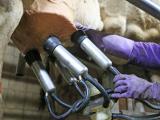Oct 4, 2011
Study: Priming with DNA vaccine improves response to H5N1 vaccine
The immune response to an H5N1 avian influenza vaccine was greatly improved in healthy adults if they were primed 24 weeks earlier with a DNA vaccine expressing the gene for the virus's hemagglutinin, according to a report from researchers at the National Institute of Allergy and Infectious Disease's (NIAID's) Vaccine Research Center. H5N1 vaccines containing the whole, inactivated virus often fail to induce high levels of antibodies, the NIAID noted in a press release about a pair of phase 1 trials, which were described today in The Lancet Infectious Diseases. Of 26 volunteers who received the prime and booster vaccines 24 weeks apart, 21 produced levels of antibodies expected to protect them from H5N1 avian flu and four times higher than the levels in volunteers who received two doses of the conventional H5N1 vaccine. But of 15 volunteers who received the booster vaccine only 4 weeks after the DNA vaccine, only 4 produced protective levels of antibodies. In several participants, the prime-boost regimen also generated broadly neutralizing antibodies directed at the hemagglutinin stem, a region that is relatively constant across many flu virus strains, the NIAID said. "The results of these studies demonstrate an important proof of concept, in that it is possible to elicit broadly neutralizing influenza antibodies in humans through vaccination," NIAID Director Anthony S. Fauci, MD, said in the press release. He called the results "an early but significant milestone on the pathway to a universal influenza vaccine that provides protection against multiple virus strains."
Oct 3 NIAID press release
Oct 4 Lancet Infect Dis abstract
Survey: Local health departments continue to suffer cuts
Local health departments (LHDs) continue to suffer in a week economy, with 55% cutting at least one program and 5,400 jobs lost nationwide, according to the latest survey released today by the National Association of County and City Health Officials (NACCHO). The survey of 968 LHDs conducted in July and August found that, from July 2010 through June 2011, 55% of all departments reduced or eliminated at least one program. The top programs cut were services for mothers and children (21% of all LHDs), personal health services (20%), emergency preparedness (20%), environmental health (18%), and immunizations (18%). Through June of this year, 43% of departments lost at least one employee, and the LHDs surveyed lost a collective 5,400 jobs. Since 2008, LHDs have lost 34,400 of 155,000 jobs because of layoffs and attrition, according to a NACCHO news release. "Local health departments have been operating on leaner budgets and fewer staff since 2008," said NACCHO Executive Director Robert M. Pestronk in the release. "Fewer staff means a loss of key protections for you and me. But with the loss also comes resourcefulness and innovating ways to make the most of the staff and funding that remain." As an example of creative response, the news release highlights Coconino Public Health Services District in Arizona, which became its own tax district in 2010 under a new law and now has a stable funding source.
Oct 4 NACCHO news release
Full NACCHO report
Laboratory response also pinched by tight budgets
Funding cuts are also threatening the nation's Laboratory Response Network (LRN), which 10 years ago tested more than 125,000 samples for Bacillus anthracis during the anthrax attacks and continues to test thousands of substances each year as part of bioterror preparedness, according to a release today from the Association of Public Health Laboratories (APHL). The LRN, formed in 1999, kicked into high gear on Oct 2, 2001, when a possible case of inhalational anthrax was identified in Florida. But now the major source of federal preparedness funding for the LRN, the Public Health Emergency Preparedness Cooperative Agreement, has been cut by one-third since its peak in the years following the anthrax attacks (from almost $1 billion to about $632 million). The current House of Representatives' version of the Pandemic and All Hazard Preparedness Act would hold funding static over the next 5 years, and other funding sources also face cuts, according to the APHL. "The whole infrastructure is being eroded," said Eric Blank, DrPH, APHL's director of public health. "I'm really worried about the next pandemic or the next emergency situation."
Oct 4 APHL press release
Bay Area schools bar students without pertussis vaccination
More than a thousand middle and high school students in California's Bay Area have been barred from school because they have not received a pertussis (whooping cough) vaccine as required by a new state law, according to Bay City News today. About 1,500 7th- through 12th-grade students in the West Contra Costa Unified School District who have not submitted signed vaccination papers were told to stay home yesterday, district spokesman Marin Trujillo said. School officials around the state have been informing parents of the new booster shot mandate for almost a year, according to the story. In nearby Oakland school district, officials have yet to turn away an estimated 1,325 students who missed the Sep 29 deadline for paperwork. California mandated booster vaccines after more than 9,000 pertussis cases were confirmed there in 2010, the most in 63 years.
Oct 4 Bay City News story




















